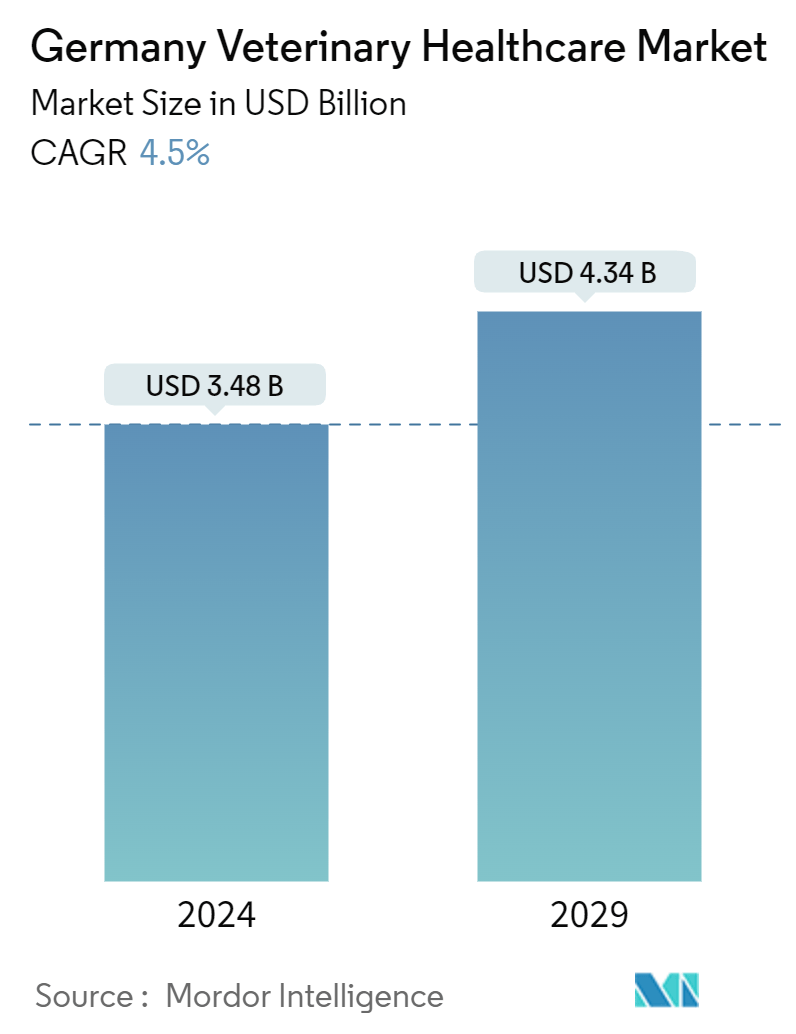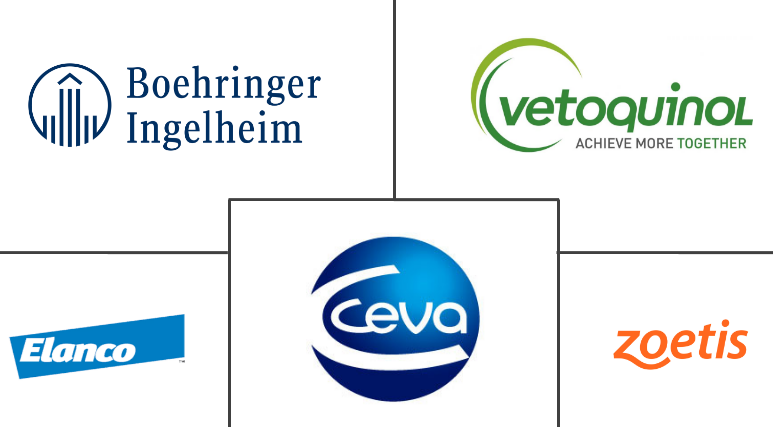Market Size of Germany Veterinary Healthcare Industry

| Study Period | 2019 - 2029 |
| Base Year For Estimation | 2023 |
| Market Size (2024) | USD 3.48 Billion |
| Market Size (2029) | USD 4.34 Billion |
| CAGR (2024 - 2029) | 4.50 % |
| Market Concentration | Medium |
Major Players
*Disclaimer: Major Players sorted in no particular order |
Germany Veterinary Healthcare Market Analysis
The Germany Veterinary Healthcare Market size is estimated at USD 3.48 billion in 2024, and is expected to reach USD 4.34 billion by 2029, growing at a CAGR of 4.5% during the forecast period (2024-2029).
The COVID-19 pandemic impacted the veterinary healthcare market by increasing the costs of animal testing and veterinary care. Supply chain disruptions and shortages of veterinary medicines were observed in several countries, primarily due to the temporary lockdowns of manufacturing sites, export bans, and increased demand for medicine for the treatment of COVID-19. For instance, according to an article published in February 2021, the demand for veterinary services and visits to pet clinics reduced in the country during the COVID-19 pandemic, impacting the growth of the veterinary healthcare market. Furthermore, according to a Health for Animals article, the World Veterinary Association (WVA) and regional veterinary organizations in Europe declared veterinary services to be essential in 2020, just like human healthcare services. As a result, a large number of veterinarians worked under the COVID-19 circumstances. The European Medicines Agency (EMA) created and implemented a few standards to guarantee the accessibility of veterinary medications on the German market. However, with pet clinic services resuming and the relaxation of COVID-19 restrictions, the German veterinary healthcare market is expected to grow over the forecast period.
According to Der Deutsche Heimtiermarkt, 47% of the households in Germany had pets in 2021. In addition, 34.7 million dogs, cats, small animals, and ornamental birds were kept by the population in the country. In Germany, laws and the veterinary administration work together to safeguard animal health. They guarantee good animal husbandry and cleanliness and efficient disease prevention and eradication efforts. It also confirms whether or not animals are given effective, authorized veterinary medicines. Therefore, it is projected that such occurrences will favor market growth in Germany throughout the forecast period.
The strategic initiatives adopted by key market players, such as product approvals, launches, partnerships, and acquisitions, are fueling the market growth. For instance, in July 2021, Boehringer Ingelheim revealed that the 2.0 version of the FreVAX smartphone app could control the FreVAX intramuscular needle-free device. It was developed to improve communication with the FreVAX system, a pig intramuscular needle-free vaccine injection device. Similarly, in November 2021, Felpreva (tigolaner/emodepside/praziquantel), to treat both internal and external parasite infestations for cats, was granted marketing authorization by the European Commission for marketing in Germany.
However, the increasing cost of animal testing and veterinary services is expected to hinder market growth.
Germany Veterinary Healthcare Industry Segmentation
As per the scope of the report, veterinary healthcare comprises the products used in the diagnosis and treatment of diseases in animals.
The Germany Veterinary Healthcare Market is Segmented by Product (Therapeutics (Vaccines, Parasiticides, Anti-infectives, Medical Feed Additives, and Other Therapeutics) and Diagnostics (Immunodiagnostic Tests, Molecular Diagnostics, Diagnostic Imaging, Clinical Chemistry, and Other Diagnostics), and Animal Type (Dogs and Cats, Horses, Ruminants, Swine, Poultry, and Other Animals). The report offers value (in USD million) for the above segments.
| By Product | |||||||
| |||||||
|
| By Animal Type | |
| Dogs and Cats | |
| Horses | |
| Ruminants | |
| Swine | |
| Poultry | |
| Other Animals |
Germany Veterinary Healthcare Market Size Summary
The veterinary healthcare market in Germany is poised for growth, driven by a combination of strategic initiatives and regulatory support. The market is experiencing a resurgence following the disruptions caused by the COVID-19 pandemic, which had initially led to increased costs and supply chain challenges. The resumption of pet clinic services and the relaxation of restrictions are expected to bolster market expansion. The presence of a significant pet population, with a substantial number of households owning pets, underscores the demand for veterinary services. Regulatory frameworks and veterinary administrations play a crucial role in ensuring animal health, which, coupled with strategic product launches and partnerships by key market players, is anticipated to propel market growth.
The market is characterized by a moderate level of fragmentation, with major players such as Boehringer Ingelheim, Zoetis, and Elanco Animal Health holding significant shares. Innovations in vaccine development and the introduction of advanced therapeutics are expected to drive demand, particularly for dogs and cats, which dominate the pet ownership landscape in Germany. The increasing adoption of pets and the rising healthcare expenses associated with them are key factors contributing to the market's expansion. Additionally, strategic investments in veterinary clinics and enhancements in veterinary practice technologies are further supporting the market's growth trajectory.
Germany Veterinary Healthcare Market Size - Table of Contents
-
1. MARKET DYNAMICS
-
1.1 Market Overview
-
1.2 Market Drivers
-
1.2.1 Advanced Technology Leading to Innovations in Animal Healthcare
-
1.2.2 Rising Awareness and Initiatives by the Government
-
1.2.3 Increasing Prevalence of Zoonotic Diseases
-
-
1.3 Market Restraints
-
1.3.1 Increasing Cost of Animal Testing and Veterinary Services
-
-
1.4 Porter's Five Forces Analysis
-
1.4.1 Threat of New Entrants
-
1.4.2 Bargaining Power of Buyers/Consumers
-
1.4.3 Bargaining Power of Suppliers
-
1.4.4 Threat of Substitute Products
-
1.4.5 Intensity of Competitive Rivalry
-
-
-
2. MARKET SEGMENTATION (Market Size by Value in USD million)
-
2.1 By Product
-
2.1.1 By Therapeutics
-
2.1.1.1 Vaccines
-
2.1.1.2 Parasiticides
-
2.1.1.3 Anti-infectives
-
2.1.1.4 Medical Feed Additives
-
2.1.1.5 Other Therapeutics
-
-
2.1.2 By Diagnostics
-
2.1.2.1 Immunodiagnostic Tests
-
2.1.2.2 Molecular Diagnostics
-
2.1.2.3 Diagnostic Imaging
-
2.1.2.4 Clinical Chemistry
-
2.1.2.5 Other Diagnostics
-
-
-
2.2 By Animal Type
-
2.2.1 Dogs and Cats
-
2.2.2 Horses
-
2.2.3 Ruminants
-
2.2.4 Swine
-
2.2.5 Poultry
-
2.2.6 Other Animals
-
-
Germany Veterinary Healthcare Market Size FAQs
How big is the Germany Veterinary Healthcare Market?
The Germany Veterinary Healthcare Market size is expected to reach USD 3.48 billion in 2024 and grow at a CAGR of 4.5% to reach USD 4.34 billion by 2029.
What is the current Germany Veterinary Healthcare Market size?
In 2024, the Germany Veterinary Healthcare Market size is expected to reach USD 3.48 billion.

